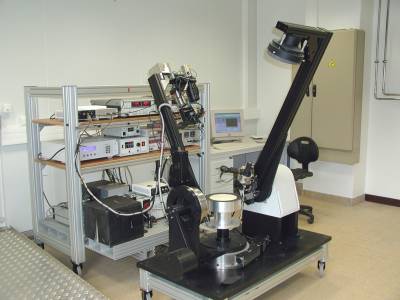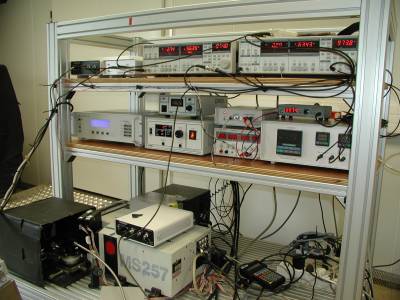SHINE Spectro-Gonio Radiometer
Laboratory Experiment facility
Facility name:
SHINE Spectro-Gonio Radiometer
Location: Institut de Planétologie et Astrophysique de Grenoble
CNRS - Université Grenoble Alpes
Saint Martin d’Hères, France
Persons in charge:
- Scientific : Bernard Schmitt, Research director & Pierre Beck, Assistant Professor
- Technical : Olivier Brissaud, Engineer
General description
This SHINE instrument is our unique home-made Spectro-Gonio Radiometer that allows to measure the bidirectional reflectance spectra and distribution functions of various types of planetary materials (granular to compact) over almost the whole solar spectrum, from the visible to the near-IR (from 400 to 4800 nm), with a high degree of radiometric accuracy (better than +/-0.5%) under most viewing geometries (illumination and observation up to almost 80°, all azimuths, phase angle > 4-10° ). The instrument is fully described in Brissaud et al. 2004, Appl. Optics, 43, 1926.
The instrument is located in a dark cold room that can be cooled down to -20°C. It is fully automatized and the data calibration and reduction are made with homemade softwares. Various types of measurements can be programmed: simple reflectance spectra at one geometry (but possibly varying with time, temperature, or physical/chemical process), full BRDF (only in open sample holder), limited angle BRDF spectra or at few wavelengths (SERAC and CarboN-IR cells), …
sample holders:
It has currently 3 major sample holder configurations:
- Open sample holders (various sizes) in cold chamber over -20°C ─ +20°C temperature range.
- The SERAC environmental cell with cryostats, pumps, pressure and temperature controllers, which allows us to introduce gas(es) of known composition and pressure (10-6 mb - 1 bar) over the sample and controlling and measuring the temperature over the -40°C ─ +80°C range.
- The CarboN-IR environmental cell extending the capacity of the previous cell for big samples (up to 300 cm3), and down to -230°C (40K) in almost fully isothermal conditions, with additional pressure and gas flux controls.
Tools and sub-systems:
A number of sample preparation tools and experiment sub-systems are available to the facility:
- For samples preparation: another cold chamber (down to -20°C), set of sample holders, several specific tools for ice sample preparation, 2 sets of sieves, grinders, mortars, saw, balances, microscope, owen, ultra-pure water, several pure gasses, wet chemistry materials a, several owens (up to 1200°C) for sample treatments.
- For the experiment: a thermodynamic volumetric system with high accuracy pressure gauges (10-6 to 1 bar), a flow meter (1-10 sccm) and pumps. He-Ne laser + detectors, camera for sample monitoring, …
Technical characteristics:
Spectral range : 0.35 - 4.5 µm (→ 5.0 µm: lower S/N) (4.2-4.3µm: atm. CO2 limited)
Spectral resolution : variable
- mini: < 0.1 nm (but S/N limited)
- maxi: 6 nm (<750nm), 12 nm (<1500nm), 24 nm (<3000nm), 48nm (>3000nm)
- Incidence angle: 0° to 85° ; resolution: 0.1° ; maximum sampling : 0.1°
- Emergence angle: 0° to 80° (to 83° for dark / fine grained samples) ; resolution : ± 2° (may be reduced to < ± 0.5°, but S/N limited) ; max. sampling : 0.1°
- Azimuth angle: 0° to 180° ; resolution : ± 2° (may be reduced to < ± 0.5°, but S/N limited) ; max. sampling : 0.1°
- Phase angle: mini to 165° ; mini : ~ 8° for bright / large grained samples ; ~ 4° for dark / fine grained samples
- Illumination diameter (nadir): 200 mm
- Observation diameter (nadir): 20 mm
Absolute:
- 0.3-1.0 µm: better than 1% over all configurations (relative to a calibrated Spectralon 0.99 reference panel)
- 1.0-2.5 µm: better than 1% over all configurations
- 2.5-5 µm : better than 2% over all configurations
Relative :
- better than 0.5% (0.3-2.5 µm)
Polarimetry options (only partly tested)
Illumination :
- linear polarization : variable 0 to 90° ; spectral range : 0.3 - 2.8 µm
Observation :
- 1 component over the 0.3 - 5µm range + unpolarized or || and ┴ components over restricted spectral range
Picture: General view of the Spectro-gonio radiometer at IPAG
Picture: General view of the instrumentation
Types: rocks, minerals, snow / ice, sulfur, … (from very bright to dark)
Texture: compact or granular
Grain size: micrometer to a few millimeters
Size:
maxi:
- 300mm diameter, 250 mm deep (for bright & coarse grained samples)
- 120 mm in diameter, 2-10 mm deep (for dark or fine grained samples)
mini:
- 25 mm x 120 mm (for principal plane observation down to 80°)
- 25 mm x 45 mm (for principal plane observation down to 60°)
- room temperature or heated
- down to -20°C (in cold room)
- down to -40°C (in SERAC environmental cell)
- down to -200°C (in CarboN-IR environmental cell)
- PC/Windows, fully software controlled (LabView©). Automatic acquisition of all spectral/geometric configurations
- typical: 15 mn for 200 spectral channels in visible (S/N dependent)
- total: 15 hours for 100 spectral channels and 100 geometries
- 0.35 - 5 µm range: fully calibrated
- polarization: tested (not available for external users)
- low temperature: tested in cold room down to -20°C ; in SERAC down to -40°C, in CarboN-IR down to -130°C
- Characteristics: SHINE Spectro-Gonio radiometer
- Article: Brissaud et al. 2004
Availability to community:
- Technical improvements/calibration (20%)
- IPAG + associated laboratories measurements (60%)
- open as Europlanet facility or to specific collaborations w. funding (20%)
References:
- Bonnefoy, N., O. Brissaud, B. Schmitt, S. Douté, M. Fily, W. Grundy, and P. Rabou 2000. Experimental system for the study of planetary surface materials’ BRDF. Remote Sensing. Rev., 19, 59-74 [doi: 10.1080/02757250009532410].
- Bonnefoy, N. 2001. Développement d’un spectrophoto-goniomètre pour l’étude de la réflectance bidirectionnelle des surfaces géophysiques. Application au soufre et perspectives pour le satellite Io. PhD Thesis, LPG - Université Joseph Fourier, Grenoble (20/11/2001).
- Brissaud, O., B. Schmitt, N. Bonnefoy, S. Douté, P. Rabou, W. Grundy, and M. Fily 2004. Spectrogonio radiometer for the study of the bidirectional reflectance and polarization functions of planetary surfaces: I. Design and tests. Appl. Optics, 43 (9), 1926-1937 [doi: 10.1364/AO.43.001926].
- Bernard, J-M, E. Quirico, O. Brissaud, G. Montagnac, , B. Reynard, P. Mc Millan, P. Coll, M-J Nguyen, F. Raulin, B. Schmitt 2006. Reflectance spectra and chemical structure of Titan’s tholins. Application to the analysis of CASSINI-HUYGENS observations. Icarus 185, 301-307 [doi: 10.1006/icar.2001.6726].
- Pommerol, A., and B. Schmitt 2008a. Strength of the H2O near-infrared absorption bands in hydrated minerals: Effects of particle size and correlation with albedo. J. Geophys. Res E, 113, E10009 [doi:10.1029/2007JE003069]
- Pommerol, A., and B. Schmitt 2008b. Strength of the H2O near-infrared absorption bands in hydrated minerals: Effects of measurement geometry. J. Geophys. Res E, 113, E12008 [doi: 10.1029/2008JE003197].
- Quirico, E., G. Montagnac, V. Lees, P. F. McMillan, C. Szopa, G. Cernogora, J-N Rouzaud, P. Simon, J-M Bernard, P. Coll, N. Fray, B. Minard, F. Raulin, B. Reynard, B. Schmitt 2008. New experimental constraints on the composition and structure of tholins. Icarus, 198, 218-231 [doi: 10.1016/j.icarus.2008.07.012].
- Pommerol, A., B. Schmitt, P. Beck, and O. Brissaud 2009. Water sorption on Martian regolith analogs: thermodynamics and near-infrared reflectance spectroscopy. Icarus, 204, 114-136 [doi: 10.1016/j.icarus.2009.06.013].
- Pommerol A. 2009. Hydratation minérale à la surface de mars : Caractérisation spectroscopique, thermodynamique et application a la télédétection. PhD Dissertation, Université Joseph Fourier, Grenoble.
- Dumont, M., O. Brissaud, G. Picard, B. Schmitt, J.C.Gallet, and Y. Arnaud, 2010. High-accuracy measurements of snow Bidirectional Reflectance Distribution Function at visible and NIR wavelengths; comparison with modelling results. Atm. Chem. Phys 10, 2507-2520. [doi: ?] (Atm. Chem. Phys. Discuss. 2009, 9, 19279-1933).
- Beck, P., A. Pommerol, B. Schmitt and O. Brissaud 2010. Kinetics of water adsorption on minerals and the breathing of the Martian regolith. J. Geophys. Res. E. 115, E10011 [doi: 10.1029/2009JE003539].
- Beck, P., E. Quirico, D. Sevestre, G. Montes-Hernandez, A. Pommerol, B. Schmitt, J-A Barrat, and P. Gillet 2011. Goethite as an alternative origin for the 3.1 µm band on dark asteroids. Astron. Astrophys., 526, A85 (correction: AA 530, C2) [doi: 10.1051/0004-6361/201015851e].
- Beck, P., J-A. Barrat, F. Grisolle, E. Quirico, B. Schmitt, F. Moynier, P. Gillet, and C. Beck 2011. NIR spectral trends of HED meteorites: Can we discriminate between the magmatic evolution, mechanical mixing and observation geometry effects? Icarus, 216, 560-571 [doi: 10.1016/j.icarus.2011.09.015].
- Grisolle F. 2013. Les condensats saisonniers de Mars : étude expérimentale de la formation et du métamorphisme de glaces de CO2. PhD Dissertation, Université Joseph Fourier, Grenoble.
- Massé, M., P. Beck, B. Schmitt, A. Pommerol, A. McEwen, V.F. Chevrier, O. Brissaud and A. Séjourné 2014. Spectroscopy and detectability of liquid brines on Mars. Planetary & Space Sciences, 92, 136-149 [doi: 10.1016/j.pss.2014.01.018].

